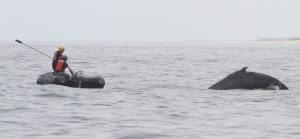July 12, 2018

Center responders used a thirty-foot pole and a hook-shaped knife to make two cuts to the entanglement. Photo courtesy of NOAA
After months of effort, the CCS Marine Animal Entanglement Response team (MAER) and many federal, state and municipal partners managed to disentangle a humpback whale in New York Harbor yesterday. While the prognosis for the whale is now much improved, it will continue to be monitored.
The young whale, first seen with its entanglement off Cape Cod last October, had a portion of gillnet gear, including rope and small floats, wrapped around its upper jaw. After that sighting, the whale took up residence around New York Harbor. The CCS team made two attempts to disentangle the whale there, in November and December, without luck. In late-June of this year, whale watchers and recreational boaters again began to report sightings of the whale. By the Fourth of July holiday week, the whale was consistently seen off Sandy Hook, New Jersey and the Verrazano Narrows by New York City. An attempt to disentangle the whale then was called off due to extremely high maritime traffic within the harbor.
With a predicted drop in traffic this week and a very good forecast, CCS began planning an operation with NOAA, the U.S. Coast Guard, New Jersey Fish and Wildlife Conservation Police (NJDEP), Monmouth County Sheriff’s Office, Middletown Fire and Rescue, and Atlantic Highlands Fire and Rescue. Personnel and vessels from all of these agencies were needed to find and stand by the whale and establish a safety perimeter for disentanglement attempts.
Early yesterday morning two team members from CCS were greeted at the Provincetown Airport by pilot Philip Greenspun, with the East Coast Aero Club, who volunteered to fly the team to New Jersey. This was critical as it reduced the amount of time the MAER team would be away from its response area off Massachusetts at one of the busiest times of the year.
Once in New Jersey the team transferred to the Sandy Hook Coast Guard Station.
As vessels left from Sandy Hook, a USCG helicopter began a search for the whale in Raritan Harbor. They soon found the whale resting between the inbound and outbound shipping lanes at the entrance to the harbor. Despite a fair bit of maritime traffic, the teams managed to establish a security zone around the whale. CCS deployed a small inflatable boat from the NJDEP vessel, Integrity, and began to make a series of slow approaches to the whale. Using a thirty-foot pole and a hook-shaped knife, the team made a two cuts to the entanglement on the whale. This left the whale with a relatively small length of line and floats lodged within the baleen. No attempt was made to remove this line as this may have caused catastrophic injury to the whale. Over time the whale should be able to shed this remaining gear.
“The operation went remarkably well” said Scott Landry of the MAER team. “The whale was found quickly and we accomplished our goal soon afterward. Now the whale needs time. Time to shed the remaining gear as it feeds and time for its immune system to stave off infection. We have done all we can do for the whale. Any attempt to remove what is left could be tremendously harmful for the whale and many whales before it have dealt with gear caught in their baleen.”
The whale watch community off New York and New Jersey have been urged to keep an eye out for the whale and monitor its entanglement for any signs of change. A few hours after the teams left the whale, whale watchers aboard the American Princess and Gotham Whale reported that the whale was actively feeding on menhaden not far from the Verrazano Bridge.
Many thanks goes to all agencies involved in this operation. A special thanks goes to Philip Greenspun for significantly reducing the amount of time the MAER team took away from its primary response area.

Our Work
Humpback Whale Research
Right Whale Research
Marine Animal Entanglement Response
Marine Geology Department
Water Quality Monitoring Program
Marine Fisheries Research
Seal Research
Shark Research
Marine Education
Interdisciplinary
Marine Debris and Plastics Program
Marine Policy Initiative
Cape Cod Climate Change Collaborative
Publications

